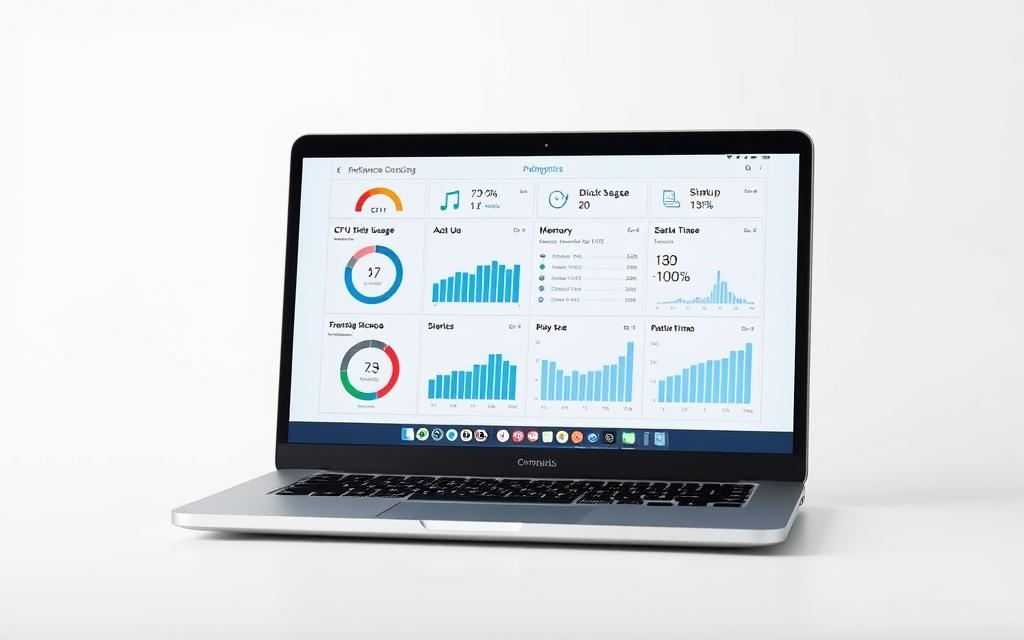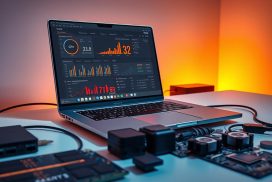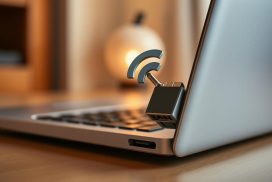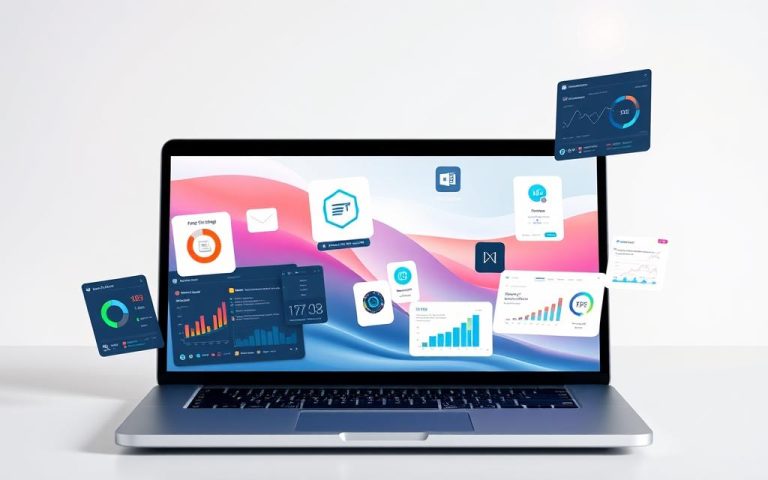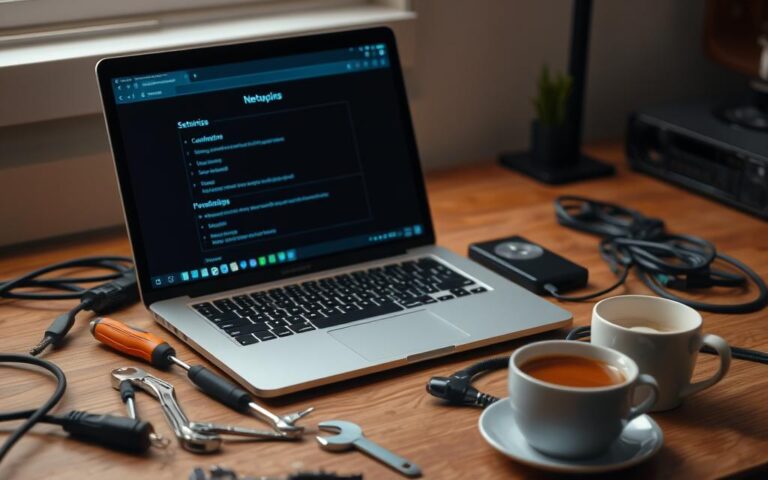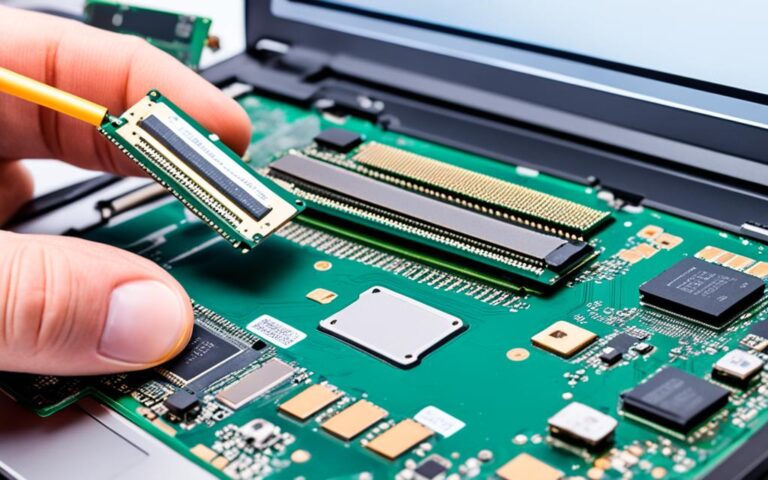5 Quick Ways to Fix a Slow Mac Laptop: Speed Up Now!
Is your Mac laptop slow? You’re not alone. Many Mac users face mac performance issues. But, there are ways to fix them.
A slow Mac can be due to an old operating system or a full hard disk. This can really slow things down. Cleaning system files and removing unused apps can help free up space.
Regular system updates are also key. Apple works hard to make newer macOS versions faster and more efficient. If your Mac is slow, checking for updates is a must.
By tackling these common problems, you can make your Mac much faster. In this article, we’ll look at five quick ways to boost your Mac’s speed. We’ll cover storage, memory, and hardware solutions.
Understanding Why Your Mac Laptop Runs Slowly
There are many reasons why a Mac laptop might slow down. Too many background processes can use up CPU and memory. Also, high-quality graphics and animations can strain the laptop’s resources. Outdated apps or macOS can also cause problems, as they might not work well with the laptop’s hardware.
Regular troubleshooting can help solve these issues. For instance, using Disk Utility to fix disk problems can boost performance. Keeping an eye on storage space is also key, as a full hard drive can slow things down a lot. Knowing what causes Mac performance problems helps users speed up their laptops.
Signs your Mac needs a boost include slow startups, crashes, and slow performance. To fix these, try clearing system cache and temporary files. Remove unused apps and manage big media files. These steps can make your Mac run faster and smoother.
| Common Causes of Mac Performance Issues | Solutions |
|---|---|
| Too many background processes | Close unnecessary processes |
| Demanding visuals | Adjust graphics settings |
| Outdated apps or macOS | Update to latest version |
By following these tips and regularly optimizing your Mac, you can keep it running fast. This ensures you get the best from your device.
Essential Tools for Mac Performance Diagnostics
For effective mac maintenance, having the right tools is key. Activity Monitor is a must-have. It shows which processes use up CPU and memory. This lets you identify and close apps that slow you down.
CleanMyMac is another great tool. It helps clean out system junk and boost your laptop’s speed. Using these tools can make your Mac run better. Cleaning caches and managing big media files also helps.
It’s important to watch CPU load, memory usage, and disk speed. These metrics help spot problems early. For instance, a high CPU load might mean it’s time to close some apps or upgrade your hardware.
https://www.youtube.com/watch?v=INpOdKPAM58
With these tools and tips, you can keep your Mac running well. Regular checks and maintenance stop performance issues. This ensures your Mac stays in top shape.
| Tool | Description |
|---|---|
| Activity Monitor | Monitors CPU and memory usage |
| CleanMyMac | Cleans up system junk and optimizes performance |
How to Fix Slow Mac Laptop Through Storage Optimisation
When it comes to mac performance optimization, storage is key. A slow macbook air often has too little storage. To speed things up, clear out system cache and temporary files, delete unused apps, and handle big media files wisely.
Recent stats show that a full hard drive slows down your Mac. Heavy data and media files cause 50% of the slowdowns. CleanMyMac can help by removing caches, logs, and old files, making your Mac faster.
- Clear system cache and temporary files to free up space
- Remove unused applications to reduce clutter and improve performance
- Manage large media files by storing them in the cloud or on an external hard drive
By taking these steps and using the right tools, you can boost your Mac’s speed. Regular cleaning and removing unused apps keeps your Mac running smoothly. This avoids the need for expensive fixes or upgrades.
| Storage Optimization Tips | Benefits |
|---|---|
| Clear system cache and temporary files | Free up space, improve performance |
| Remove unused applications | Reduce clutter, improve performance |
| Manage large media files | Free up space, improve performance |
Memory Management Solutions for Better Performance
To make your MacBook Pro faster, focus on memory management. Running out of RAM slows down your laptop a lot. Tools like CleanMyMac can help free up RAM and boost performance. You can find more tips here.
It’s important to close apps that use a lot of RAM. Regularly checking your Mac’s memory use helps spot these apps. By managing RAM well, your Mac will run better and faster. For example, closing unused tabs in Google Chrome saves memory.
Here are some tips to better manage your Mac’s memory:
- Use CleanMyMac to free up RAM and optimize performance
- Identify and quit resource-hungry processes
- Regularly monitor your Mac’s memory usage
- Close unnecessary tabs in Google Chrome

By using these tips, you can make your Mac faster and avoid slowdowns. Good memory management is essential for a smooth-running Mac. With the right tools and methods, your slow MacBook Pro will work better.
| RAM Size | Recommended Use |
|---|---|
| 8 GB | Text processing and internet browsing |
| 16 GB | Photo and video editing |
| 32 GB | Gaming and resource-intensive applications |
Optimising Your Mac’s Start-up Process
To make your Mac run better, focus on its start-up. A slow start can be annoying and might show deeper problems. With the right mac optimization tips, you can make your Mac start up faster and work better.
Keeping your Mac in good shape is key. It stops login items and launch agents from slowing things down. To manage these, go to System Preferences > Users & Groups > Login Items. Remove anything you don’t need to speed up your start-up.
Also, think about cutting down on visual effects and updating your system settings. Try booting in Safe Mode to find and fix slow start-up problems. By following these mac optimization tips and keeping up with mac maintenance, your Mac will run smoothly and fast.
Key Optimisation Steps
- Manage login items and launch agents
- Reduce visual effects
- Update system preferences
- Boot in Safe Mode to troubleshoot issues
By taking these steps and keeping your Mac updated, you’ll get the best performance. Always update your macOS. New versions bring speed boosts and bug fixes that make your Mac faster and more efficient.
Background Processes and System Resources
To tackle mac performance issues, understanding background processes is key. These processes use CPU and RAM, even when you’re not aware. Activity Monitor lets you see how much each process is using, helping you find the ones slowing you down.
Sorting processes by CPU or memory usage is a good first step. This helps you find out which ones are using the most resources. But, be careful when quitting processes you don’t know. Use Terminal or the Force Quit menu instead to avoid problems.
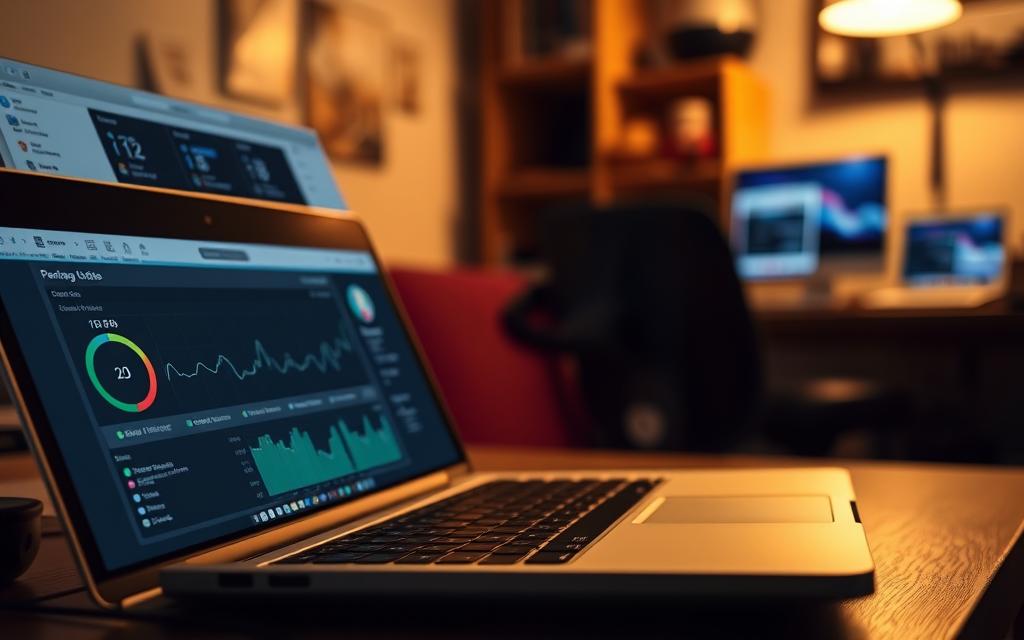
Tools like Spindump and Memory Cleaner can also help. They diagnose issues and free up RAM. Regularly cleaning out unnecessary processes and managing login items can also boost your Mac’s speed. These steps help reduce the impact of background processes and improve your Mac’s performance.
Here are some tips for managing background processes:
- Check and remove processes you don’t need regularly.
- Use Activity Monitor to find out which processes are using a lot of resources.
- Be careful when quitting processes you’re not familiar with.
- Use Terminal and the Force Quit menu to manage processes safely.
By following these tips and keeping an eye on background processes, you can make sure your Mac runs well. This helps solve mac performance issues and keeps your Mac fast.
Hardware Solutions for Mac Speed Enhancement
For those with a slow macbook air, upgrading hardware can help. One top tip is to switch to a solid-state drive (SSD). This can make your Mac much faster. Many say an SSD upgrade is a game-changer for speed and smoothness.
Before upgrading, check your Mac’s current hardware. Look at the RAM and storage. Adding more RAM or swapping a hard drive for an SSD can boost performance. For example, going from 8 GB to 16 GB or 32 GB RAM can noticeably speed up your Mac.
SSD Upgrade Considerations
When choosing an SSD, make sure it fits your Mac. There are SATA, PCIe, and NVMe SSDs. Pick one that matches your Mac’s specs and meets your needs.
RAM Upgrade Options
Upgrading RAM is another smart move for a slow macbook air. More RAM means you can run more apps at once. This cuts down on the need to switch data between RAM and hard drive, making your Mac faster and more responsive.
External Storage Solutions
For extra storage, consider external drives or SSDs. They give you more room for files, which can speed up your Mac. This is because your internal drive has less data to handle.
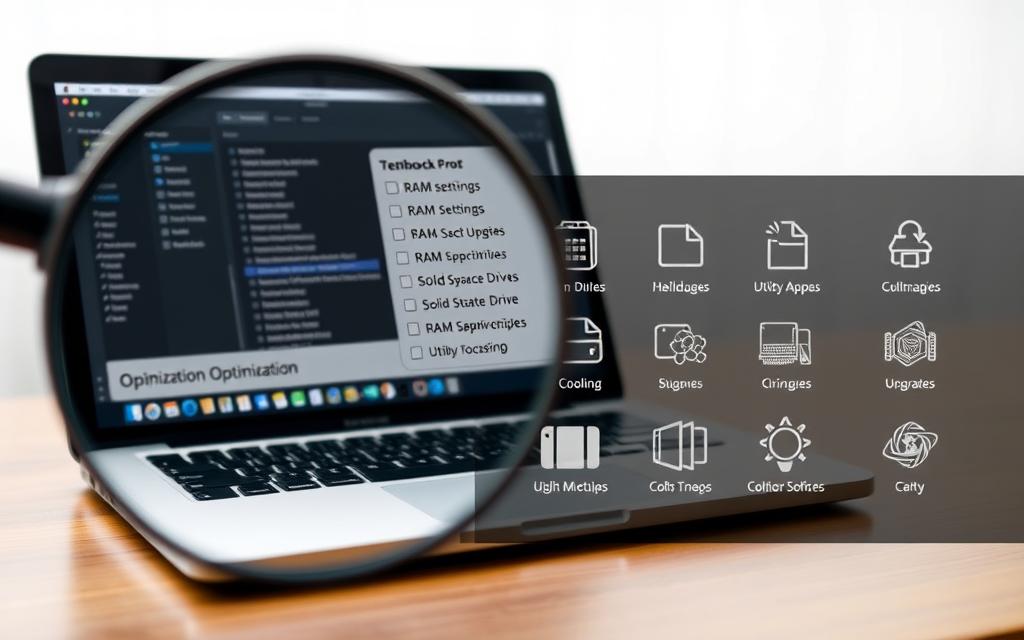
Exploring these hardware upgrades can greatly enhance your Mac’s speed and performance. Whether it’s an SSD, more RAM, or external storage, there are many ways to make your slow macbook air faster and more enjoyable to use.
| Hardware Upgrade | Benefits |
|---|---|
| SSD Upgrade | Improved performance, faster boot times, and increased responsiveness |
| RAM Upgrade | Increased multitasking capabilities, improved performance, and reduced lag |
| External Storage Solutions | Additional storage space, improved performance, and reduced clutter on internal drive |
Maintaining Optimal Mac Performance Long-term
To keep your Mac running smoothly, regular mac maintenance is key. This means setting up a routine to check your system. It helps keep it free from clutter and running well. This way, you avoid problems like slow performance and unreliability.
Creating a regular maintenance schedule is important. It includes tasks like cleaning up system junk and managing big media files. By doing these tasks regularly, you stop your Mac from slowing down.
Regular Maintenance Schedule
A good maintenance plan helps spot and fix problems early. It includes:
- Regularly emptying the Trash to reclaim valuable storage space
- Transferring large media files to an external drive to free up space
- Disabling hardware acceleration in resource-intensive applications
Professional Service Recommendations
Professional advice is also vital for keeping your Mac in top shape. You can get help from Apple support or use tools like CleanMyMac. They help find and fix performance issues.
Performance Monitoring Tools
Performance monitoring tools are great for keeping an eye on your Mac. They let you check CPU usage, disk space, and more. This way, you can act fast to keep your Mac running smoothly and avoid slowdowns.
When to Consider Professional Mac Support
Knowing when to get professional help for Mac issues is key. Many problems can be fixed with mac troubleshooting and DIY steps. But, some need expert care. If you’ve tried to mac speed up and it didn’t work, it’s time to call a pro.
Signs your Mac needs a pro include frequent crashes, slow downs, and malware. If you see these, get help from a skilled tech. They can find and fix the problem.
At times, mac speed up might need hardware fixes or upgrades. A pro can guide you on what to do and ensure it’s done right. Getting help when needed keeps your Mac running well and safe.
Benefits of professional Mac support include:
- Expert diagnosis and repair of complex issues
- Hardware upgrades and installations
- Malware removal and protection
- Performance optimization and mac speed up
Conclusion: Keeping Your Mac Running at Peak Performance
To keep your Mac laptop running well, you need to take a few steps. By fixing common mac performance issues and using the mac optimization tips from this article, your Mac will stay fast and efficient. This will help it last longer.
Doing regular maintenance is key. This includes clearing system caches, managing storage, and keeping software up to date. Also, watching how your Mac uses resources and tweaking its start-up can make it more responsive.
If your Mac keeps having problems, you might need to upgrade its hardware or get help from a Mac expert. Being proactive with your Mac’s care means it will run smoothly. You’ll get to enjoy using it without any hassle.
FAQ
Is your Mac laptop running slowly?
Yes, many Mac users face slow performance. But, there are solutions to fix these issues.
What are the common causes of Mac performance issues?
Issues often stem from too many background processes and demanding visuals. Outdated apps or macOS and malware infections also play a part.
What tools can help diagnose and fix performance issues on a Mac laptop?
Tools like Activity Monitor and CleanMyMac are key. They help spot and stop processes that slow you down. They also optimise your laptop’s performance.
How can storage optimisation help fix a slow Mac laptop?
Clearing system cache and temporary files helps. Removing unused apps and managing large media files also frees up space. This improves performance.
How can memory management solutions improve Mac laptop performance?
CleanMyMac can free up RAM and boost performance. Identifying and stopping processes that use too much memory also helps.
How can optimising the start-up process improve Mac laptop speed?
Managing login items and reducing visual effects helps. Updating system preferences also optimises start-up and boosts performance.
How can managing background processes and system resources improve Mac laptop performance?
Using Activity Monitor to identify and stop processes that use too much resources is key. This frees up resources for other apps, improving performance.
What hardware solutions can enhance Mac laptop speed and performance?
Upgrading to an SSD and increasing RAM significantly boosts speed and performance. External storage solutions also help.
How can you maintain optimal Mac performance long-term?
Regular maintenance and professional service recommendations are vital. Using performance monitoring tools also helps keep your Mac running smoothly.
When should you consider professional Mac support?
If you’re stuck on common issues or notice your laptop needs advanced care, professional support is a good idea.
